David McFall R.A. (1919 - 1988)
Sculptor
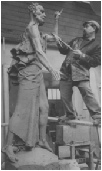
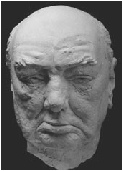
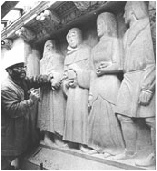
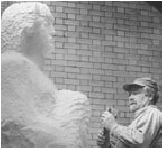

THE CHURCHILL BRONZES
David McFall had a series of sittings with Sir Winston Churchill in 1958 and was the last sculptor to model Churchill from life. He had been commissioned to produce a monumental statue for Sir Winston's constituency at Woodford Green.
The first sittings took place at the Villa La Pausa, Rocquebrune, Cap Martin, France where Sir Winston was guest of honour of Emery Reeves and his wife Wendy. McFall's diaries show that he travelled to France on 28/1/1958. He found Churchill ill in bed and the first sitting took place on 3/2/58 with 4 further sittings finishing on 8/2/1958. These sittings produced the portrait head exhibited here and known as The Rocquebrune Head; McFall made a plaster from the clay in his hotel room on 9/2/1958, returning with it to London the following day. The finished plaster first went to the foundry on 28/2/1958. During March and April 1958 McFall worked at his studio on a preliminary figure sketch. On 11/5/1958 he began another series of sittings with Churchill at Chartwell, with further sittings on 16/5/1958, 30/5/1958, 2/6/1958 and 6/6/1958. On the 6th June McFall also modelled Churchill's right hand and cast a plaster of it three days later. On the same day, 9th June 1958, the plaster cast of the Churchill bust, known as the Chartwell Bust, was made. In 1963 this bust would be presented to the Royal Academy as McFall's Diploma Work on his Election as a Royal Academician.
Meanwhile, work proceeded through 1958 and 1959 on the statue for Woodford Green. A 34.5" high maquette was made for the finished statue which was 8' 6" high. The finished plaster of the full size work went to the foundry on 10/2/59 with bronze castings taking place from April until completion on 2nd September 1959. The first bronze of the maquette was also produced in late April 1959. The finished statue was unveiled at Woodford on 31/10/59 by Field Marshall Viscount Montgomery with Sir Winston Churchill and David McFall present among a large crowd of people.
THE ROCQUEBRUNE HEAD
On 28/1/1958 McFall travelled to the south of France where
Churchill was staying with friends, Emery and Wendy Reves,
at Villa La Pausa, Rocquebrune to undertake a first head
study for the statue. When he arrived he found Churchill ill
in bed, and it later transpired that he had suffered his first
stroke, which is visible in the drooping mouth of this study. The first sitting was on 3/2/1958 and the last of 5 sittings was on 6/2/1958. McFall then plaster moulded the clay in his hotel room and left to return to London on 11/2/1958 where he cast the plaster on 13/2/1958, and it went to the foundry on 28/2/1958.
The Daily Herald of 31/3/1958 said:
"Look at the sculpted head of Churchill... we have seen Churchill stubborn, Churchill grave, Churchill triumphant - but surely this is Churchill the man of sorrow. The promising Scots sculptor David McFall confirmed my view yesterday. The man who has been commissioned by Churchill's constituents in Woodford Essex to produce a 9ft statue of the Grand Old Man told me: ‘When I went to Rocquebrune to sculpt him, just before his illness, I was struck by something in him I had not expected to see. Tragedy. His age is a matter of great sorrow to him, and I have caught him at a very tragic moment of his life. I felt I had to do this intimate, unhappy head of him. I shall not use this head for the statue. The statue will be of a legend. But this is just the head of a man. In his glory - and disappointment’ ".
When it was exhibited at the Royal Academy Summer Exhibition of 1958 it was widely acknowledged as being an outstanding work of portrait sculpture. The Keeper of the Royal Academy, Peter Greenham CBE, RA, PPRBA, wrote "His portrait of Churchill is so incomparably the best ever done of him that it is astonishing that it is not on permanent public display” (letter 17/2/83).
And the art critic David Carritt wrote on 12/5/1958: "A petty rule has robbed the Tate of this" [reference to Chantrey bequest rules which it breached by being modelled in France] "If any exhibit in this year's Royal Academy should be bought for the nation, surely it is David McFall's bronze head of Sir Winston Churchill. The President of the Royal Academy, Sir Charles Wheeler, thinks so. So does the Director of the Tate Gallery Sir John Rothenstein. So do such austere judges as Professor Gowing and Sir William Coldstream... It is sad that the Tate should be deprived of this moving portrait.”
McFall was already receiving at this early stage ‘artistic input’ from Wendy Reves and, via her, from Lady Churchill:
Letter 4/3/1958 from Wendy Reves, Villa Pausa, to David McFall:
"...Of course I am thrilled that you have been given the commission as who could do it better ... I have spoken a great deal about you to Lady Churchill ... I showed Lady Churchill your letter and she's very anxious to know you and will, on her return to London, make a point to meet you and discuss your work with you. She has made an interesting point, dear David, and that is she would greatly prefer a 'seated statue'. Her first reason is that to put the face of Sir Winston of today onto a body of Sir Winston during the war days would, of course, be most peculiar looking and, if the entire statue is done after the manner of him today - then it should be seated. Also she feels that Roosevelt's statue (standing) is very unattractive and fears the results might be similar! She's very interested indeed in your statue-to-be and I feel she will be a great help to you. I pass on these thoughts of hers on the subject as she wished me to do so! In any case you will soon be meeting her and she will tell it all to you in person - but, she does have reason in saying this - don't you think? Of course, you can realize how frantic we have all been over Sir Winston's illness - but thank the dear God above ... he has come out of it and seems even more fit than before (as yet we have not taken him "out" but before the week is over I'm sure he'll be back into his normal pattern of life ...".
Letter 20/3/1958 from Wendy Reves, Villa Pausa, to David McFall:
"...Our great man has had a slight relapse - nothing serious but it was necessary for him to go again to his bed for several days. Poor lamb - he is very discouraged. I believe it will take some time for him to regain his strength as the medicines were strong and weakening - alas ! ... Lady Churchill will remain here until his return but greatly looks forward to meeting you upon her return... I found the [photo of] the plaster Churchill most imposing and powerful ... the eyes too closed is my only criticism but then I know - as you explained - you wanted to capture him as you saw him and, indeed, he was rather sleepy during those days. We now know that it was the beginning of his illness - and his health was not at its best when you were here! I am so happy that you came when you did as it may be a very long time before he can undertake a ‘sitting’ again...".
Churchill was sufficiently recovered by May and June 1958 to undertake a further six sittings at his Chartwell home, from which emerged another head study and the final statue.
THE CHARTWELL BUST
John Keatley, a friend of the sculptor, says (letter 8/5/1993): "...McFall told him that the Churchill family did not like the Rocquebrune head (it was after his stroke and this is obvious from the distortion in his mouth). They persuaded him to do another head which, while less accurate, was more flattering" [the Chartwell bust – 1958/6]. It had been agreed with the commissioning committee that the statue should portray Churchill as he was in 1944, and the Chartwell bust was intended to represent this time 14 years previously. It is much closer to the head of the final statue although, as will be seen, the final representation was not achieved without much controversy and some revision. The Chartwell bust was presented to the Royal Academy as his diploma work on McFall’s election in 1963 as a full Academician (he had been an Associate RA since 1955).
this photograph of the work in progress (below) shows McFall using the Chartwell bust as his model (the Rocquebrune head is in the background).
SKETCH MODEL FOR STATUE
McFall produced a 3 feet high maquette or sketch model of the final statue so that the commissioning committee could approve the pose before proceeding to the final statue. It is sometimes referred to as “Churchill crossing the lawns at Chartwell”, which was its source. As well as the committee Lady Churchill visited the sculptor’s studio to inspect the model. The model was approved and McFall proceeded to the full-scale statue.
THE WOODFORD CHURCHILL
It was during the production of the final statue that controversy arose. Undoubtedly the early face on the statue departed somewhat from the Chartwell study, but the matter was not helped by some top-lit photography of the work-in-progress that was widely published and resulted in a storm of complaints that McFall was depicting Churchill as ‘gorilla-like’. It must have been disheartening for a sensitive artist to have his most important work to date so criticised, particularly as Lady Churchill made her feelings plain:
Letter from Lady Churchill (Chartwell): 13/12/1958
“Dear Mr McFall, I tried unsuccessfully to reach you on the telephone this morning, as I wanted to have a talk with you about the statue. I think it is a remarkable achievement; but I am disturbed at what to me, seems an exaggeration - indeed (almost - crossed out) a caricature of Winston. Here are two photographs taken during the war period. In both we have the projecting lower lip, but not swollen as it appears to be in the statue. I think he looks quite fierce enough in photograph No. 2! I have lived with him now for fifty years and I can never remember him looking in the least like the ferocious representation, say in Mr Karsh's famous photograph. The angry, indignant expression was obtained by Mr Karsh snatching my Husband's cigar from his mouth, and immediately registering his furious expression, but this is a manufactured expression and not his natural one. I am afraid it is too late for anything to be done? But I think angry and brutal expressions are particularly out of place because during the War whenever there was a bad crisis, my husband was always calm and serene. Please forgive me. But I do feel just a touch might make the statue live.”
[This depiction of her ‘serene’ husband was not necessarily as others saw him: Lord Brabazon of Tara in his autobiography writes: "...There was a series of meetings during the war that I can never erase from my memory ... in my opinion they were the most unpleasant meetings I ever attended. The issue was grave, but the way Churchill treated everyone was almost unbearable. He usually appeared after his early afternoon sleep in the vilest of tempers, and having such a problem to face did not improve it. He behaved as if he were a bullying schoolmaster. Everyone, in his opinion, was a halfwit; and if anyone said anything he was jumped on and snubbed. His chief butt was Sir Archibald Sinclair, Secretary of State for Air, one of his cabinet colleagues. The abuse and insults Winston heaped upon him were unbelievable ... I know how the situation affected the Prime Minister, but the general cursing everyone was not the best way of inspiring incentive and imagination towards a solution of the problem. I am not an admirer of Sutherland's painting of Churchill - nor do I like those of Maugham or Beaverbrook - but I do say with little fear of contradiction that his portrait exactly portrays the man as he appeared to the committee whose unfortunate duty it was to attend."].
Nevertheless, McFall took the criticism and made adjustments.
the commissioning committee approves the clay
The New York Herald Tribune 2/11/1959 in the report of the unveiling:
"Churchill likes statue – his parliamentary constituency were worried whether he would like the statue unveiled yesterday. At the unveiling the old statesman climbed slowly down from the speaker's stand and made a half circle to examine the bronze figure from every angle. "Very nice" he said. And the crowd applauded, probably in relief, for some critics had earlier described the statue as a baggy, bullet-headed gorilla. What most of them did not know was that Sir Winston had also seen the early photographs on which this condemnation was based and had made a few pungent but friendly suggestions as a man who is not unversed in the arts himself. Sculptor David McFall did a quick face-lifting job on his model and created a figure which, although obviously that of an old man, gives a great impression of rugged power... ". The photographs which caused the hostility were taken too early" Mr McFall explained. "The people will be proud of this statue."
In an article in The Sketch 10/9/1958 Louis T Stanley wrote:
"The most arresting piece was the statue of Sir Winston Churchill ... standing 8 ft high it is a work of unusual strength with a mass of subtle detail in its making. A few hours earlier, I had listened to an Academician state that in his statue McFall had aimed consciously at ugliness. That is absurd... the basis of the Churchill likeness lies in the shape of the skull and in the bony structure of the face. It brings out his fierce, almost demonic energy." The statue was also praised by the commissioning committee in a letter to The Times 24/1/1959 from Sir Stuart Mallinson, Trustee of the WSC Commemoration Fund: "...photographs [of the statue in progress] have been adversely criticised... these photographs were taken of an unfinished statue in the first stage of sculpture - clay.... the stage photographed in no way represents the final effect in bronze. It must be remembered that they were taken of an 8'6" statue in a small studio where it was impossible for the photographer to get any distance from it...The sponsors feel that while it would have been possible to produce a statue of Sir Winston in his more cherubic aspect, this statue will convey what they wished - the Prime Minister whose voice held the nation together, brought hope to those in darkness, and defied the power of Hitler; and in the opinion of many who have seen it even at this stage, this work of Mr David McFall is a masterpiece."
McFall himself recollected the sittings and finished work in January 1978, including comparisons with the Graham Sutherland portrait which was destroyed by Lady Churchill:
“It is an interesting comparison to note that, in one respect, the portrait sculptor has an advantage over the painter in that the sitter can watch the sculptor’s progress as he works. Churchill pointed this out to me and was fascinated to watch me at work; I was working on one knee which I think pleased him” [McFall commonly used this technique with subjects to avoid putting them on a pedestal, which he considered produced a more natural likeness]. Whereas in the case of the Sutherland portrait, the finished canvas came as a considerable shock seen for the first time. Commenting on the work [the Rocquebrune head], Sir Winston remarked to a friend that he had realised for the first time that he really was an old man. The friend asked me later – couldn’t you cheat a little? I couldn’t. This was a human document and I was not going to alter it … the sculptor must have the concentration to dismiss the sitter’s advice as work proceeds. Sir Winston repeatedly demonstrated with flattened hand what he believed to be the exceptional height of his forehead. ‘Observe’ he would say, ‘that my forehead measures exactly half of my head.’ Epstein told me that Churchill had made the same observation to him, but Sir Jacob mischievously pointed out that we all look lofty as seen in the shaving mirror. More poignantly Sir Winston asked Epstein to leave out ‘all that scraggy skin under my chin’. I well remember that he did so, because I cast his original clay model immediately after the third sitting. I did a second sculpture, which is at Chartwell, making him look more the statesman, which I didn’t like so much. At the time, no-one cared much about him; he was bored, he had read everything, and his contemporaries were all dead. I showed him crossing the lawns at Chartwell Manor. He could still walk unaided, but it took a lot of resolution. He seemed to have the weight of the whole world on his shoulder. If it is any consolation to Mr Sutherland, I thought that his finished canvas had the same fault as my statue, that is to the point of being laboured and strained."
During and after the period of making the Woodford statue, McFall made other studies of Churchill which are depicted below:
1958/4 Churchill's Hands 1958/5 Churchill. Small Head
1970/2 Sketch for a Churchill Monument
1968/4 Sir W.S. Churchill
1970/15 Churchill medallion
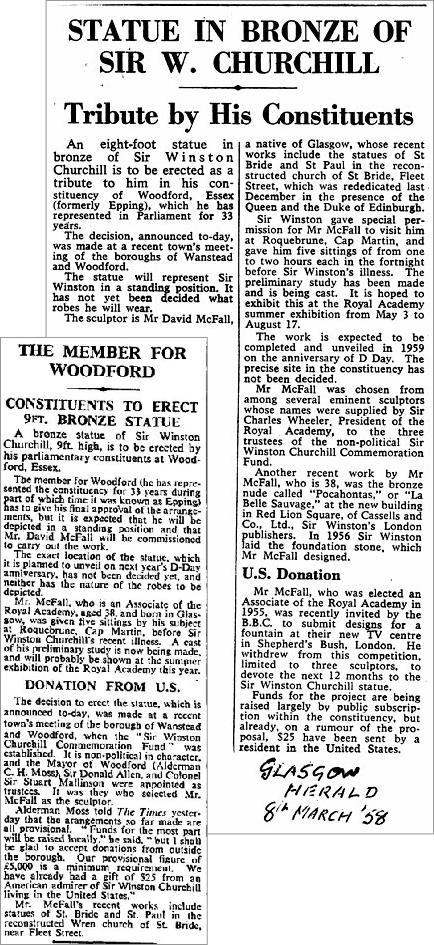
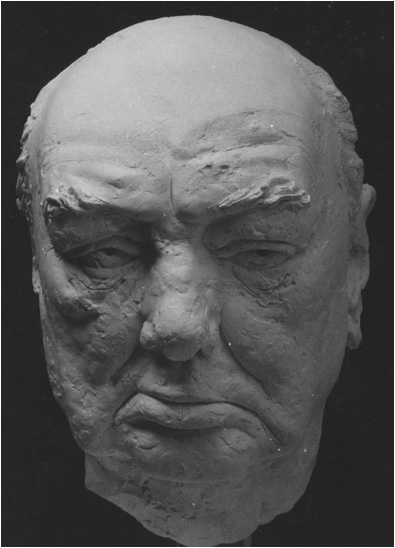
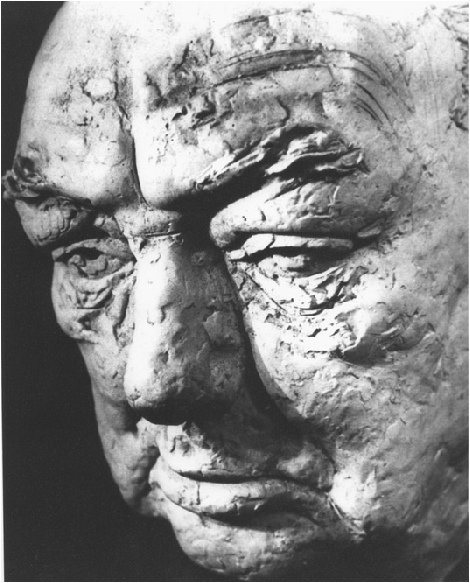
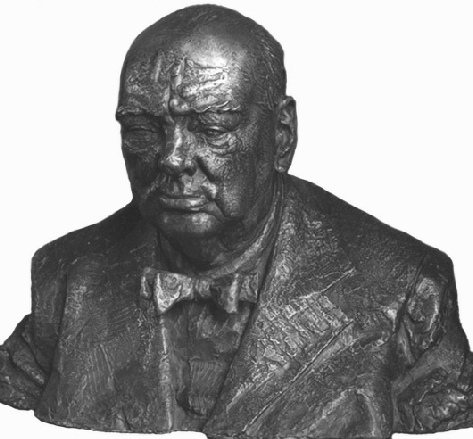



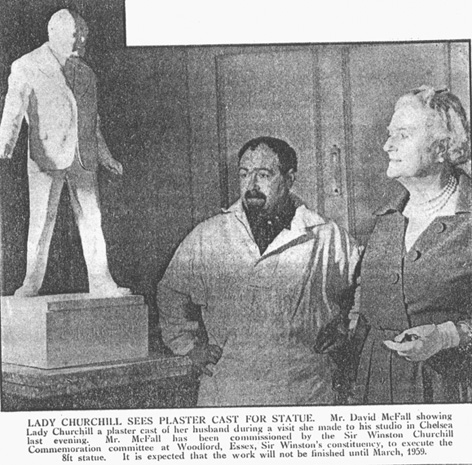
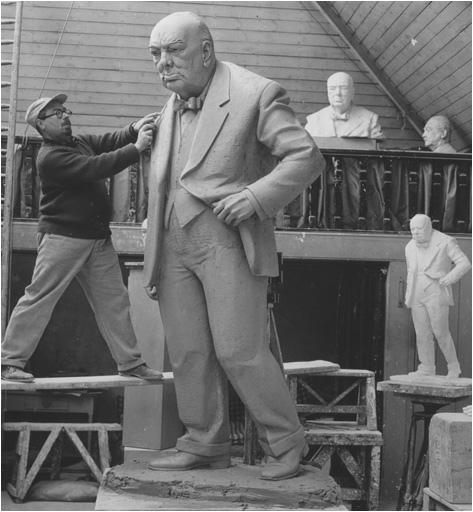

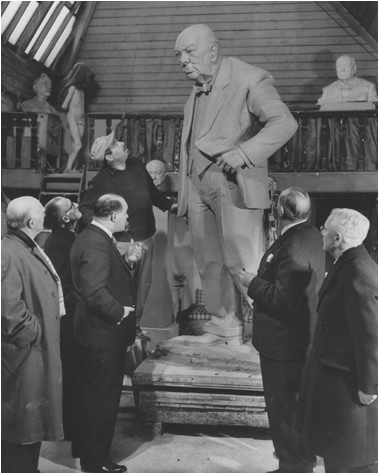
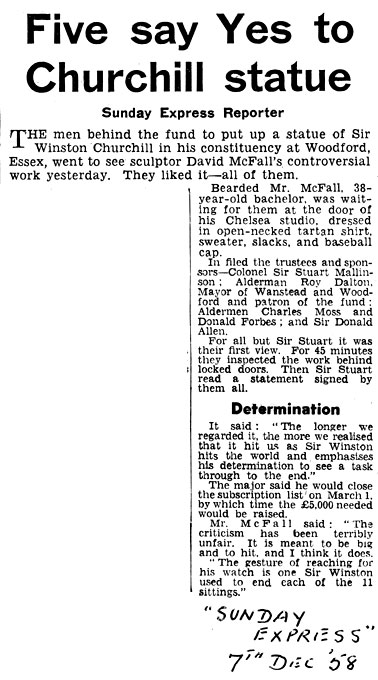

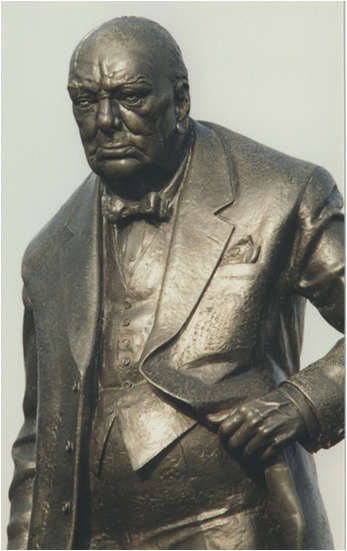
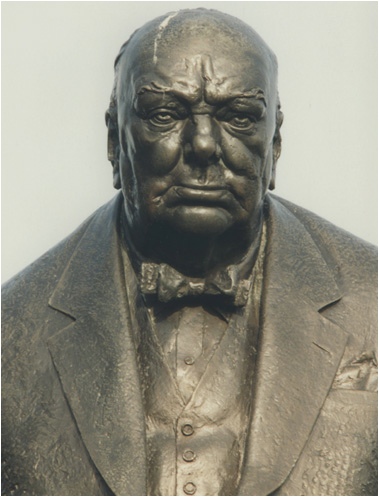
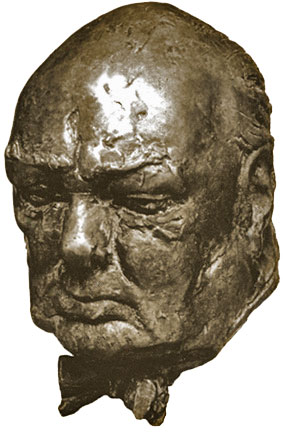
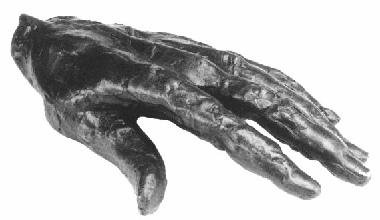
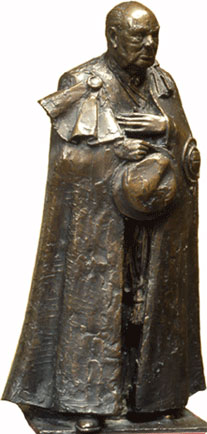
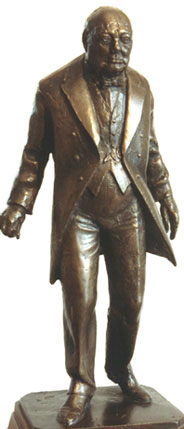
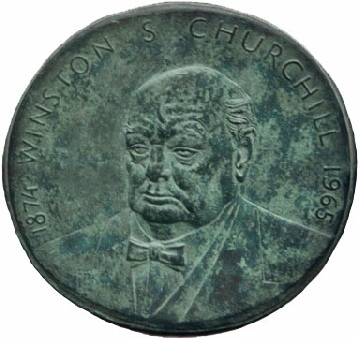
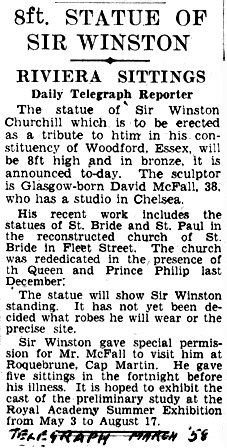
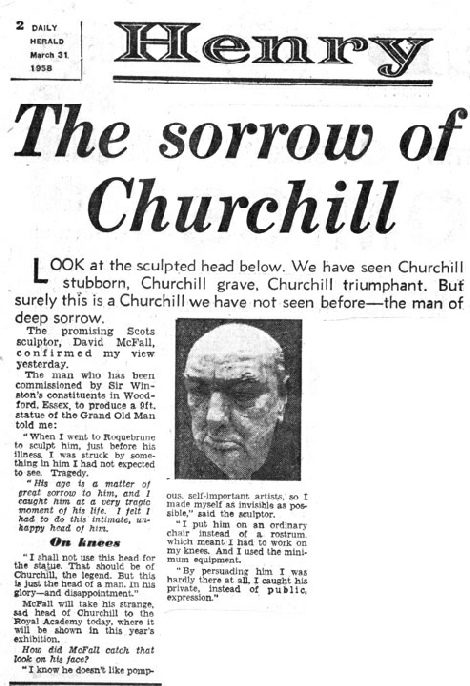
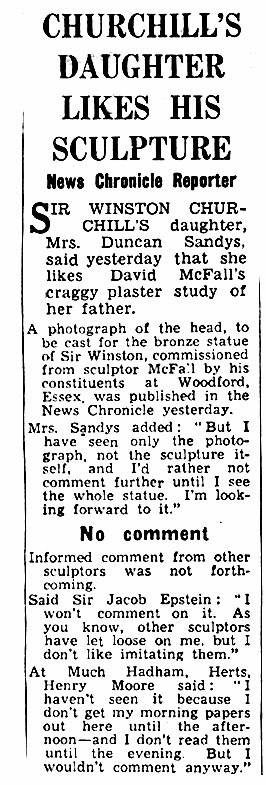
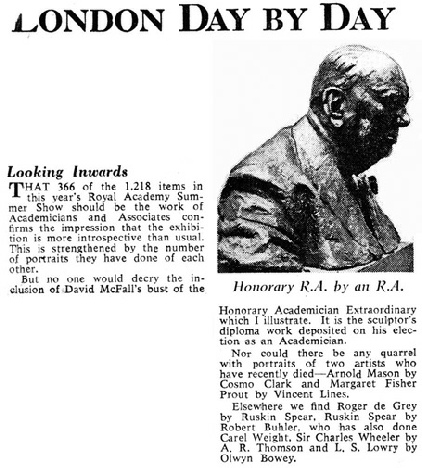


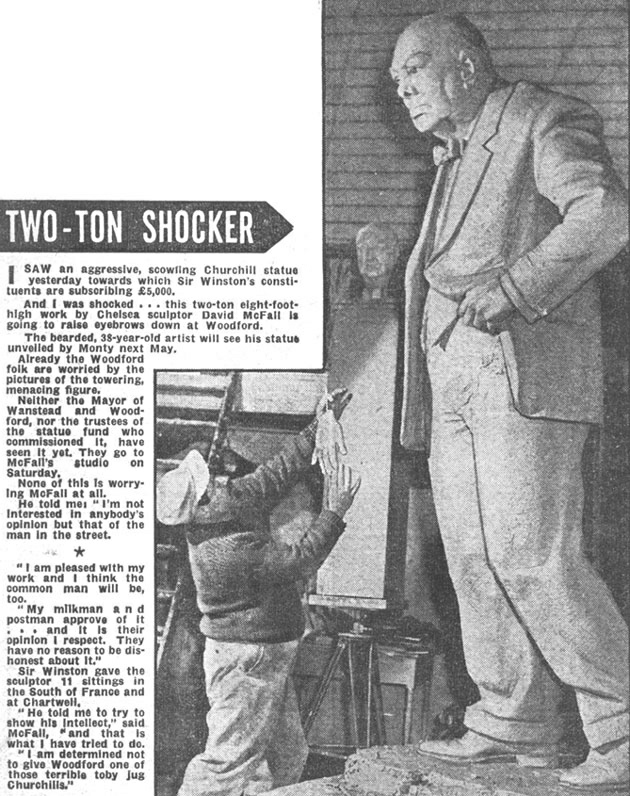

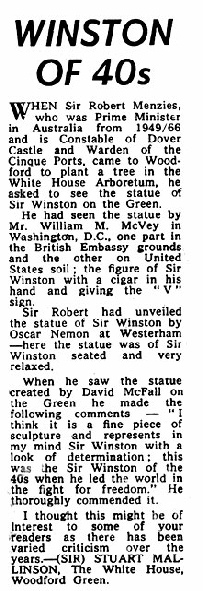
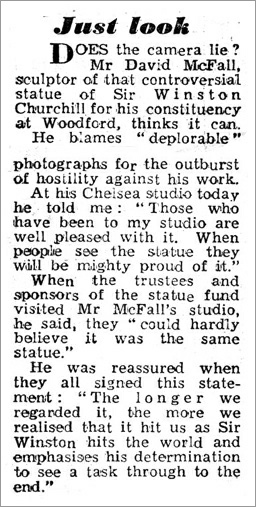
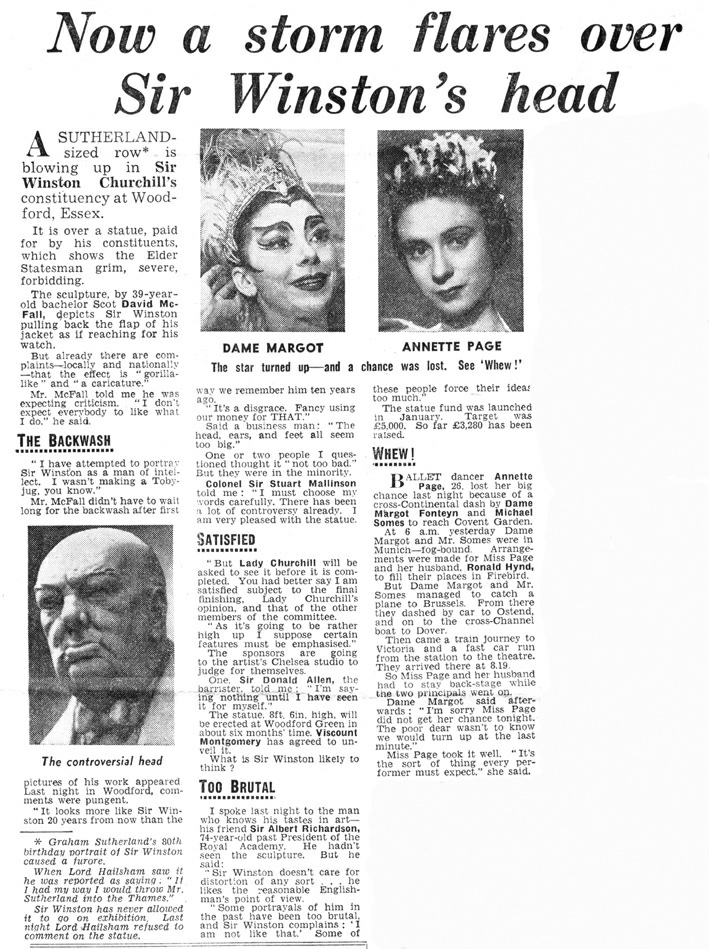
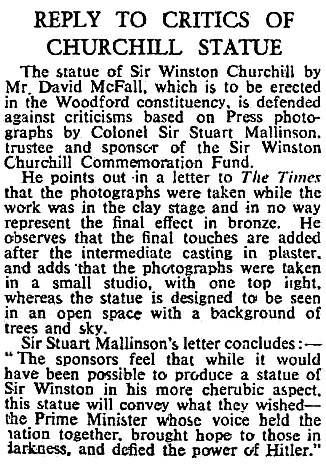

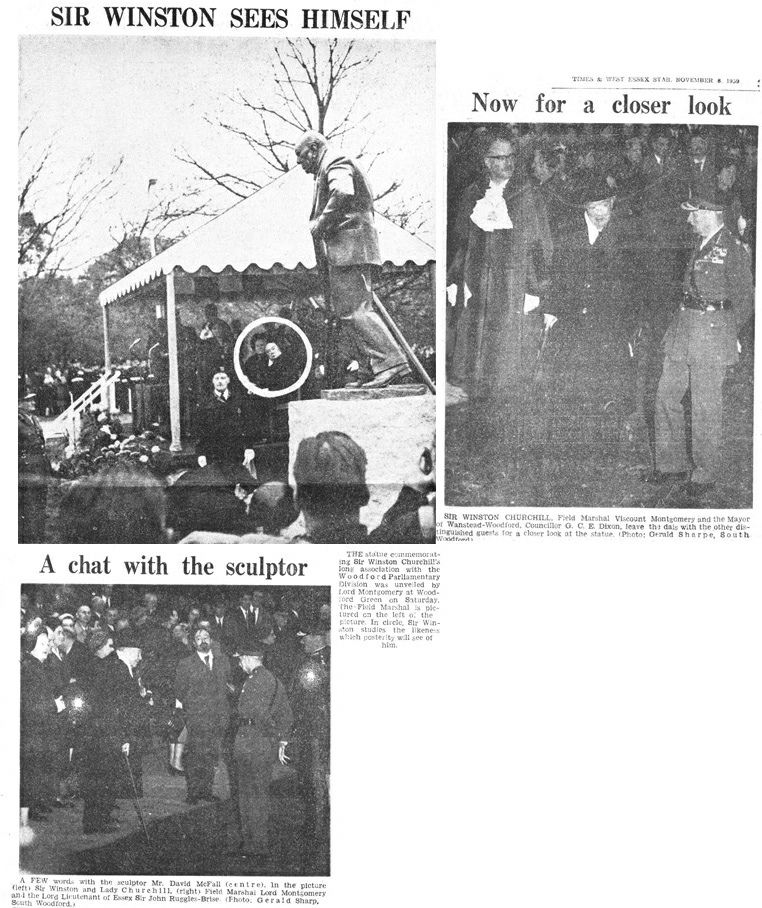
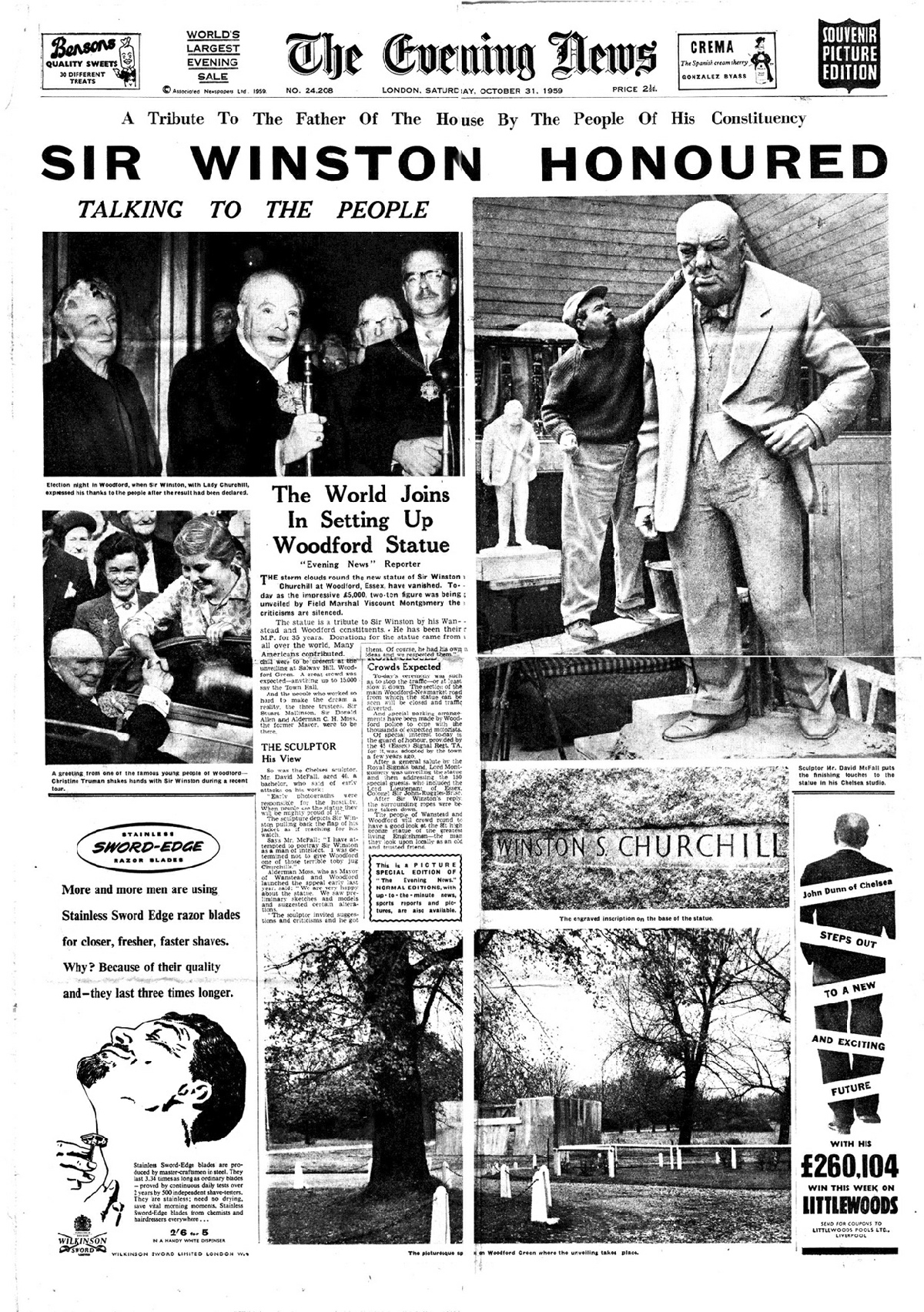
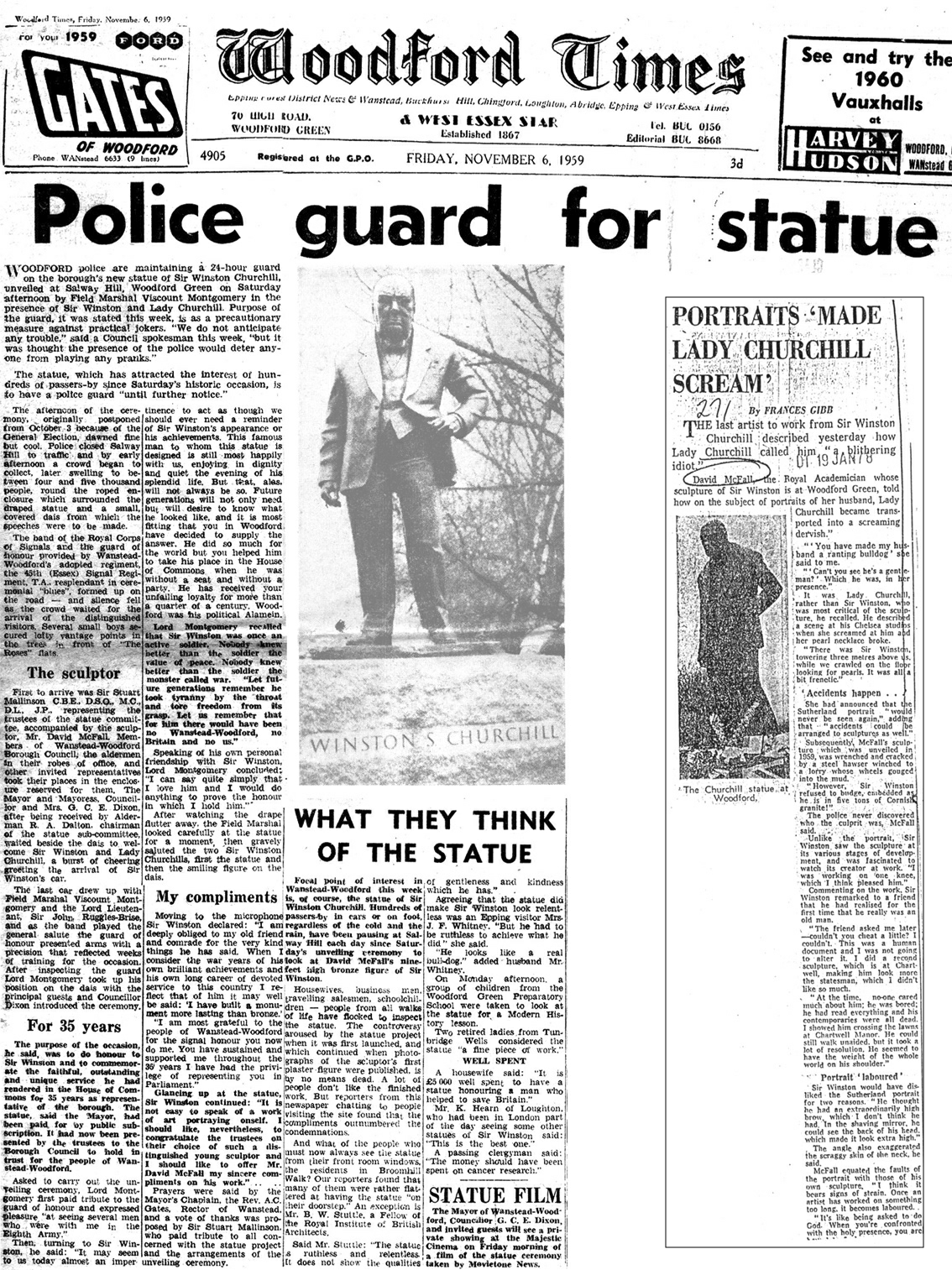
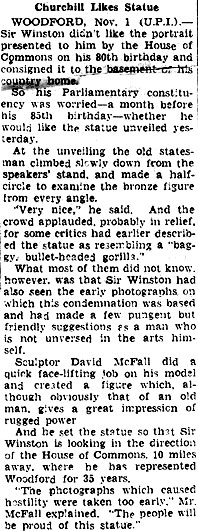
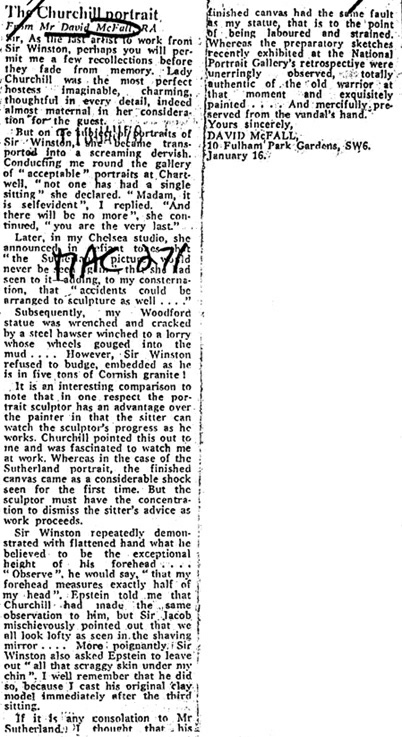

All rights reserved
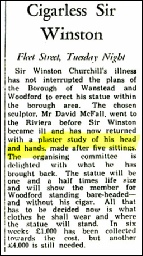
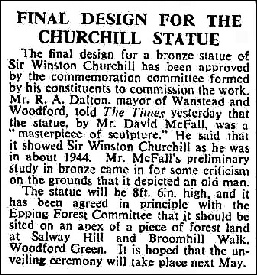
Click on the photos for more information
| Animals |
| Busts and Heads |
| Children |
| Churchill studies |
| Lettering |
| Medals coins plates |
| Reliefs |
| Stone carvings |
| Contemporary British Artists |
| On Epstein |
| Picasso |
| The art of portrait sculpture |
| Letters |
| Palliser |
| Son of Man |
| Press |
| Obituaries |
| Memorial address |